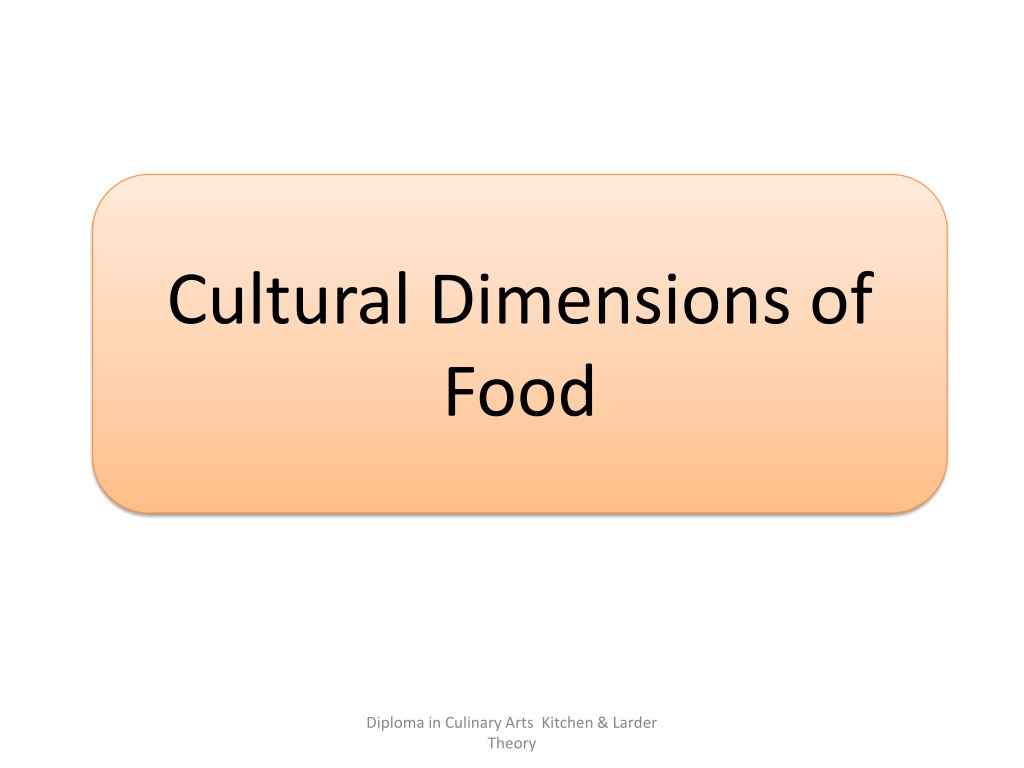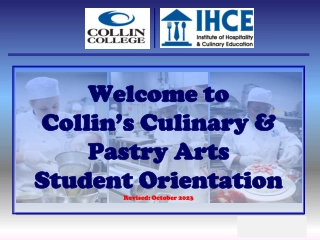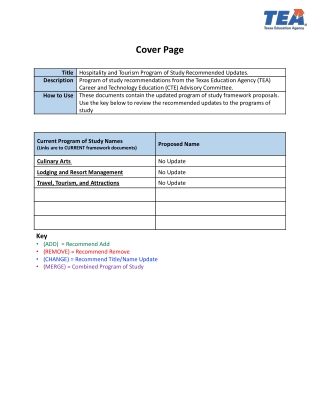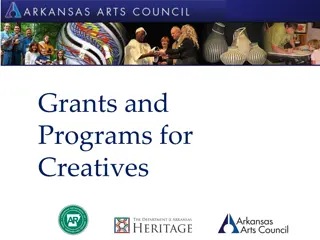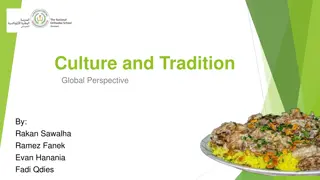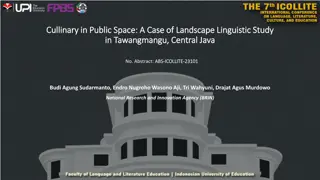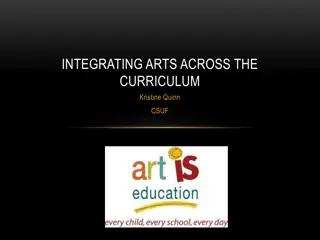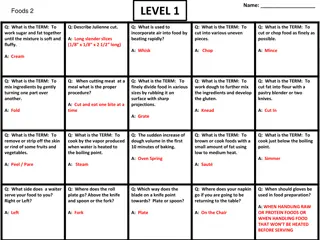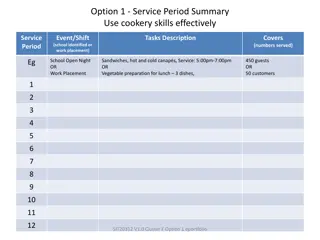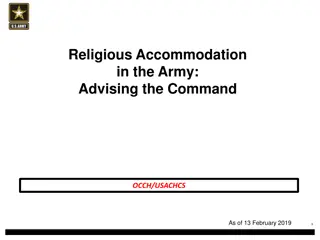Understanding the Cultural Dimensions of Food and Religious Influences in Culinary Arts
Explore the impact of religious beliefs on food traditions and dietary restrictions across different cultures in the culinary world. Learn about the influence of major world religions on eating habits, food choices, and culinary practices. Discover how various religious groups, such as Christians, observe dietary restrictions and associate specific foods with religious feasts and occasions.
Download Presentation

Please find below an Image/Link to download the presentation.
The content on the website is provided AS IS for your information and personal use only. It may not be sold, licensed, or shared on other websites without obtaining consent from the author. Download presentation by click this link. If you encounter any issues during the download, it is possible that the publisher has removed the file from their server.
E N D
Presentation Transcript
Cultural Dimensions of Food Diploma in Culinary Arts Kitchen & Larder Theory
Learning Outcomes Analysing the dimensions of food & eating habits within, society, due to religious influences & different dietary convictions . An overview of the Major World Religions & Minority Religious Group. Indentifying the food restrictions of religious & dietary groups. Diploma in Culinary Arts Kitchen & Larder Theory
Cultural Dimensions of Food: Religious Influences Diploma in Culinary Arts Kitchen & Larder Theory
Cultural Dimensions of Food: Religious Influences Nearly 86% of the world s population is religious,there are roughly 4,200 religions in the world. Religion is an organized collection of belief systems, cultural systems, and world views that relate humanity to spirituality & moral values. Religion influences eating & dietary habits due to food restrictions which influence what is eaten due to fasts, feasts, celebrations and anniversaries Diploma in Culinary Arts Kitchen & Larder Theory
Cultural Dimensions of Food: Religious Groups Diploma in Culinary Arts Kitchen & Larder Theory
Cultural Dimensions of Food,Religious Groups: Christians Christianity represents about a third of the world s population and is the world s largest religion. Sub Categories of Christianity: Catholicism (or Roman Catholicism) Mormonism (including the Church of Jesus Christ of Latter- Day Saints) Jehovah s Witnesses Orthodox Christianity Protestant Christianity Diploma in Culinary Arts Kitchen & Larder Theory
Cultural Dimensions of Food,Religious Groups: Christians Dietary Restrictions Generally no food restrictions except for the consumption of meat on Ash Wednesday (first day of Lent) & on Good Friday. Mormons emphasize on eating wholesome food& abstaining from drinking tea, coffee, & alcohol. Christians associate foods with certain religious feasts Shrove Tuesday: (the day before Lent) Pancakes Good Friday: Hot cross buns , Caramelli tal harrub (Carob sweet) reminder of Christ s crucifixion. Easter Sunday: Baby lamb, Simnel cakes (made with marzipan and chocolate), Easter eggs & Figolli are eaten as a symbol of new life and the Resurrection. Diploma in Culinary Arts Kitchen & Larder Theory
Cultural Dimensions of Food,Religious Groups: Islam The duties of all Muslims are known as the Five Pillars of Islam and are: Recite the shahadah at least once. declaring there is no god except God, and Muhammed is God's Massenger Perform the salat (prayer) 5 times a day while facing the Kaaba in Mecca. Donate regularly to charity via the zakat, a 2.5% charity tax, and through additional donations to the needy. Fast during the month of Ramadan, (the ninth month of the Muslim calendar)the month that Muhammad received the Qur an from Allah. Make pilgrimage to Mecca at least once in their life time. Diploma in Culinary Arts Kitchen & Larder Theory
Cultural Dimensions of Food,Religious Groups: Muslim Dietary Restrictions Muslims celebrate the birth of Mohammed at the end of February or early in March. Alcohol and pork are forbidden in their diet. Only meat that has been prepared & slaughtered according to Muslim custom of Halal , done by a certified Halal butcher During Ramadan, which lasts for one month, Muslims do not eat or drink anything from dawn to sunset. The end of the fast is celebrated with a feast called Idd-ul-Fitar, with special foods. Muslims from Middle Eastern countries would favour a dish like lamb stew with okra those from the Far East curry & rice Diploma in Culinary Arts Kitchen & Larder Theory
Cultural Dimensions of Food,Religious Groups: Hinduism The origins of Hinduism can be traced to the Indus Valley civilization sometime between 4000 and 2500 BCE. The basis of Hinduism is the belief in the unity of everything, called Brahman. The purpose of life & enlightenment is to be part of God and when you died you rejoin with God. These cycles of birth, life and death known as Samsara. One s progress towards enlightenment is measured by his karma (deed). This is the accumulation of all one s good and bad deeds and this determines the person s next reincarnation, devotion to God help one to be reborn at a higher level. Bad acts and thoughts will cause one to be born at a lower level, as a person or even an animal. Hindus follow a strict caste system which determines the standing of each person. The caste one is born into is the result of the karma from their previous life. Only members of the highest caste, the brahmins, may perform the Hindu religious rituals & hold positions of authority within the temples Diploma in Culinary Arts Kitchen & Larder Theory
Cultural Dimensions of Food,Religious Groups: Hindus Dietary Restrictions Most Hindus do not eat meat (strict Hindus are vegetarians) and none eats beef since the cow is considered sacred. Holi is the festival that celebrates the end of winter and the arrival of spring. Raksha Bandha celebrates the ties between brothers and sisters at the end of July or in August Janam Ashtami celebrates the birth of Krishna, also in August. Dussehra is the festival of good over evil; Diwali is the festival of light, celebrating light over darkness, held in October or November. Foods such as Samosas (triangles of pastry containing vegetables), banana fudge and vegetable dishes of all kinds, as well as favourite foods, are eaten to celebrate. Diploma in Culinary Arts Kitchen & Larder Theory
Cultural Dimensions of Food,Religious Groups: Judaism Judaism, originated with a divine covenant between the God of the ancient Israelites and Abraham around 2000 BCE. The next leader of the Israelites, Moses, led his people out of captivity in Egypt and received the Law from God. Joshua later led them into the promised land. Jews believe in one creator who alone is to be worshipped as absolute ruler of the universe, monitors peoples activities and rewards good deeds and punishes evil. The Torah was revealed to Moses by God and cannot be changed Jews believe in the inherent goodness of the world and its inhabitants as creations of God and do not require a saviour to save them from original sin. They believe they are God s chosen people and that the Messiah will arrive in the future Diploma in Culinary Arts Kitchen & Larder Theory
Cultural Dimensions of Food,Religious Groups: Judaism (Kosher) Dietary Restrictions Jewish dietary laws are known as Kashrut, are among the most complex of all religious food practices. The term Kosher, or Kasher means fit and describes all foods that are permitted for consumption that is stated in the Torah . Food must be prepared & cooked in a designated Kosher Kitchen & must be Kosher certified. A Kosher kitchen is divided into separate sections one for dairy, one for meat and one for pareve foods (eggs , fish, grains, vegetables ,& fruits ) . Different sets of utensils, pots, pans, plates, knives, chopping boards, one for meat and poultry and the other for dairy foods. Diploma in Culinary Arts Kitchen & Larder Theory
Cultural Dimensions of Food,Religious Groups: Judaism (Kosher) Dietary Restrictions No meat ,offal's ,milk & foods made from by-products of pork , camel & rabbits, birds of prey , animals that are scavengers and shellfish. All meat has to be slaughtered by a qualified kosher butcher (SHOCHET) If meat was eaten in the same day, one must wait six hours before consuming any dairy products. Meat must have all traces of blood remove by soaking in salt & water The sciatic nerve and its adjoining blood vessels certain fat, known as chelev, which surrounds the vital organs and the liver. Eating meat and dairy products at the same dish or meal No wine, unless its kosher wine Dairy products & cheeses containing animal fats & enzymes (rennet) Eggs that have blood spots. Rodents, reptiles, amphibians, and insects are all forbidden. Diploma in Culinary Arts Kitchen & Larder Theory
Cultural Dimensions of Food,Religious Groups: Judaism (Kosher) Dietary Accepted Requirements Fish is acceptable as long as it has fins and scales (tuna, salmon, carp & herrings). All animals with split hooves and which chew the cud ( sheep , goats, deer & cows) Birds that are traditionally considered kosher, such as the goose, duck, chicken, and turkey All products that grow in the soil or on plants, bushes, or trees are kosher. Fruits and vegetables are permitted, but must be inspected for bugs . All kosher milk products must derive from kosher animals. Fish, eggs, fruits, vegetables and grains can be eaten with either meat or dairy Diploma in Culinary Arts Kitchen & Larder Theory
Cultural Dimensions of Food,Religious Groups: Judaism (Kosher) Dietary Accepted Requirements The Jewish Sabbath, from sunset on Friday to sunset on Saturday, is a day of rest. In the evening plaited bread called chollah is broken into pieces and eaten. A special meal is served to celebrate the Passover as a reminder of the exodus of the Jews from Egypt. Matzo, an unleavened crisp bread, is served Pentecost celebrates the giving of the Ten Commandments to Moses on Mount Sinai; cheesecake is now a traditional dish served at this celebration. Hanukkah, the Jewish Festival of Lights in December, is a time of dedication, when pancakes and a potato dish, potato latkes, are usually eaten. Diploma in Culinary Arts Kitchen & Larder Theory
Cultural Dimensions of Food,Religious Groups: Kosher Dietary Restrictions Menu Which of the following foods in this menu is not Kosher Meli Melo of smoked Salmon and Swordfish dressed with grape fruit segments, avocado panna cotta extra virgin olive oil ___ Cream of Wild Mushroom soup ___ Pan- seared Scottish Turbot nestled on a compote of creamed leeks complemented with a almond & caper beurre noisette Or Roast tenderloin of Venison nestled on braised red cabbage served with glazed baby radishes and golden raisins, pomme Mousseline, bitter chocolate and port cafe au lait ___ White Chocolate & Mango mousse, served with a Tia Maria ice cream , medley of forest fruits Diploma in Culinary Arts Kitchen & Larder Theory
Cultural Dimensions of Food,Religious Groups: Kosher Dietary Restrictions Menu Meli Melo of smoked Salmon and Swordfish dressed with grape fruit segments, avocado Panna cotta extra virgin olive oil ___ Cream of Wild Mushroom soup ___ Pan- seared Scottish Turbot nestled on a compote of creamed leeks complemented with a almond & caper beurre noisette Or Roast tenderloin of Venison nestled on braised red cabbage served with glazed baby radishes and golden raisins, pomme Mousseline, bitter chocolate and port cafe au lait ___ White Chocolate & Mango mousse, served with a Tia Maria ice cream , medley of forest fruits Diploma in Culinary Arts Kitchen & Larder Theory
Cultural Dimensions of Food,Religious Groups: Sikhism The Sikh faith was founded by Shri Guru Nanak Dev Ji in the Punjab area, now Pakistan. Sikhs believe in a single formless God with many names, who can be known through meditation. Sikhs pray many times each day and are prohibited from worshipping idols or icons. They believe in samsara, karma, and reincarnation as Hindus do but reject the caste system. They believe that everyone has equal status in the eyes of God. Diploma in Culinary Arts Kitchen & Larder Theory
Cultural Dimensions of Food,Religious Groups: Sikhism Dietary Restrictions Do not have strict rules regarding food but many are vegetarians. Baisakhi day in April celebrates the new year and is the day Sikhs are baptised into their faith. Diwali &Guru Nana K s birthday are also days of celebration. Diploma in Culinary Arts Kitchen & Larder Theory
Cultural Dimensions of Food,Religious Groups: Buddhism Buddhism developed out of the teachings of Siddhartha Gautama who, in 535 BCE, reached enlightenment and assumed the title Buddha. After his death the Buddha s teachings were written down, called the Tripitaka. Buddhists believe in reincarnation and that one must go through cycles of birth, life, and death. After many such cycles, they can attain Nirvana. In general, Buddhists do not believe in any type of God. Buddhism has integrated many regional religious rituals, beliefs and customs into it as it has spread throughout Asia Diploma in Culinary Arts Kitchen & Larder Theory
Cultural Dimensions of Food,Religious Groups: Buddhism Dietary Restrictions Many Buddhists are vegetarians Buddhist's specifically avoid eating: Intoxicants and drugs that may interfere with there concentration, Garlic and onions because they supposedly inflame the passions, Meat from carnivores and birds of prey, and Animals which would have to be killed specifically for their consumption. Since most live in India and China, certain foods & dishes may vary according to the country & culture. Vesak in May is the festival to celebrate the life of the Buddha. Diploma in Culinary Arts Kitchen & Larder Theory
Cultural Dimensions of Food,Religious Groups: Shinto Shinto is an ancient Japanese religion founded in 500+ BC, closely tied to nature. which recognizes the existence of various Kami , nature dieties (gods or goddess, divinity) . Shinto has no founder or holy book. Its tenets and rituals have been passed from generation to generation. The Four Affirmations in Shinto: Tradition and family: the family is the main mechanism by which traditions are preserved. Love of nature: nature is sacred and natural objects are to be worshipped as sacred spirits. Physical cleanliness: they must take baths, wash their hands, and rinse their mouth often. Matsuri : festival which honours the spirits. Diploma in Culinary Arts Kitchen & Larder Theory
Cultural Dimensions of Food,Religious Groups: Shinto Dietary Restrictions In the past meats, including fowl and fish, were not widely eaten in the Shinto diet due to the reverence of all living things observed in the faith. Rice has long been a staple food in the Shinto diet others include sake, seaweed, fruits and vegetables. Mochi, a tender rice cake, is the most easily identifiable item in the Shinto diet, and is made at many of the traditional annual Shinto festivals, like Haru Matsuri or Shinko-sai. Diploma in Culinary Arts Kitchen & Larder Theory
Cultural Dimensions of Food,Religious Groups: Rastafarianism The Rastafarian movement is a "messianic religious-political movement" that began in the Jamaican slums in the 1920s and 30s, having 1 million followers worldwide The most famous Rastafarian is Bob Marley. Rastafarians believe in the Judeo-Christian God, whom they call Jah. In general, Rastafarian beliefs are based in Judaism and Christianity, with an emphasis on Old Testament laws and prophecies and the Book of Revelation. According to Rastafarian belief the only true God is the late Ethiopian emperor Haile Selassie (originally known as Ras Tafari), and Ethiopia is the true Zion. The basis of a Rastafarian diet consist of Ital or I-tal foods, natural & pure foods from the earth. Diploma in Culinary Arts Kitchen & Larder Theory
Cultural Dimensions of Food,Religious Groups: Rastafarian Dietary Restrictions Pork , Shellfish & Alcohol is never consumed. Most Rastafarian are vegetarians ,meat from rabbit, camel, horse and birds of prey is forbidden, as they are unclean. Fish without scales. Eggs are also avoided are not considered to be a natural food for human consumption. Milk from a cow or any other animal is also considered to be unnatural food Foods which contain any type of artificial additives or chemicals, processed foods, preservative, artificial sweeteners or artificial colorants Canned foods, Rock salt, Caffeine. Some Rastafarians do not cook & use metal cooking pots & utensils Diploma in Culinary Arts Kitchen & Larder Theory
